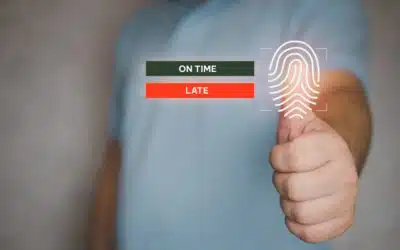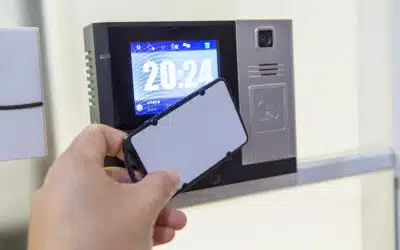Time and Attendance (T&A) is used by organisations to measure the exact time that employees work for them and is used in payroll and workforce management. In this article, we help you understand what is time and attendance and who is likely to use it.
What is the definition of Time and Attendance?
Time and Attendance is the process of tracking hours worked by employees.

How does Time and Attendance work?
In a 20th Century factory, this was a manual system often associated with a mechanical clock and a card. This gave the process the well-used name of “clocking in and clocking out”.
Employees may have manually completed a timesheet, writing down their hours and signing the record, and that information was used for payroll and benefits.
More modern systems have digitised the process and use GPS mobile apps, biometric face recognition and other high-tech features to track time
In this article, we try to answer your questions so that you can have a great understanding of what modern time and attendance software is and what functions it performs.
How is Time and Attendance software used?
It is most often found where organisations have a large number of staff who meet some or all of the following criteria:
- Hourly paid
- Shift, night time and weekend workers
- Larger numbers or complex organisations such as a retailer with multiple stores
- Remote or mobile workers
- Contingent workers (such as agency staff)
- Complicated contractual terms such as night time premium and overtime rates
- Complex working time regulations or union agreements to follow
In short, businesses use Time and Attendance software because keeping track of hundreds or thousands of start and end shift times or transferring it from paper to payroll software is unrealistic for their organisation.

What is the difference between Time and Attendance and Workforce Management?
Time and Attendance (T&A) is a subset of Workforce Management. A WFM system should include a range of different tools including time and attendance, AI, scheduling, analytics and much more. T&A can work on its own and could be as simple as a time sheet where people sign for their hours, such a system would not be a workforce management system.
How should I benchmark Time and Attendance system?
As mentioned above, a T&A system can include a spreadsheet; however, we wouldn’t recommend that as best of breed. A modern system should include the following:
- Cloud-based
- A high degree of automation, such as auto-match of correct shifts
- Unified hardware and software
- Multiple choice of “clock in” device ( biometric, mobile app, GPS, card readers etc)
- Self-service tools for staff to see their clock in a clock out times
- Direct integration into other WFM tools
- Integration into payroll software
- Secure and GDPR compliant.

Why should I use Time and Attendance software in an organisation?
Good Time and Attendance processes form part of a Workforce Management strategy which helps ensure organisations have an efficient and well-run. Some of the key benefits include:
- 100% accurate payroll with no queries – this is the goal of every payroll department. It can only be achieved with accurate time and attendance records in a digital format.
- Reduced administration costs
- Improved relationship between employees and management
- Eliminate buddy punching and other forms of time fraud
- Reduce costs of staffing
- Improve oversight of offsite employees
- Speed up the approval process for hours worked and ensure there are auditable controls in place regarding the approval of many organisations largest costs
- Prevent double paying for the same shift, for example, when someone covers sickness – make sure you pay the correct employee
- Ensure compliance with working time directive and other labour regulations.
- Prevent employee burnout by managing excessive overtime
Do You Want To Find Out Which T&A Solution Is Best For Your Business?
Simply book a call with one of our T&A professionals below.




